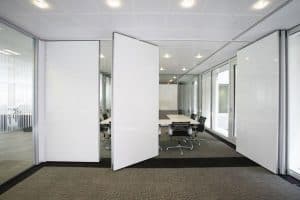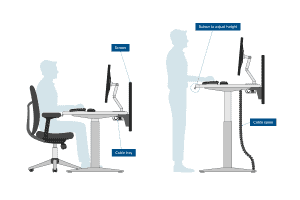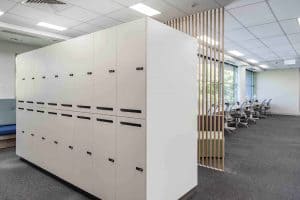Ergonomics is about designing a work environment that optimises human well-being and overall performance. Many Australian workplaces today, have seen the benefits of applying ergonomic principles to reduce health risks and improve productivity.
The nature of work is constantly changing. It comes as no surprise that ergonomic design in our workspaces has to be responsive. Spaces are becoming more flexible and multi-purpose. In this article we will look at three design trends responding to changing work needs and the value of collective workspaces.
 Flexible Interiors
Flexible Interiors
The increasing need for multi-purpose workspaces means adaptability is a core part of the interior design brief. Internal movable partitions and wall systems are becoming more popular as they can transform the flow and capacity of a work area quickly. Open spaces can allow small groups to meet up easily without formality. At the same time, we have seen how ‘focused work’ is encouraging a return to private work sections. Adjustable wall systems may be the way to go in your next office fit-out.
Integrated Technology & Automation
Ergonomic furniture such as adjustable desks, chairs and benches are standard in today’s offices, as the benefits of ergonomic design in the physical environment have clearly been demonstrated. However, ergonomic principles also apply to the ‘systems and processes’ of how we work to promote optimal health & performance. Automation and integrated technology in office equipment can help employees maintain good practices by automating specifics such as desk or chair height. This ensures that equipment can easily be adjusted to the requirements of the individual, especially when working in shared desk spaces or across multiple offices.
 Integrated Technology & Automation
Integrated Technology & Automation
Ergonomic furniture such as adjustable desks, chairs and benches are standard in today’s offices, as the benefits of ergonomic design in the physical environment have clearly been demonstrated. However, ergonomic principles also apply to the ‘systems and processes’ of how we work to promote optimal health & performance. Automation and integrated technology in office equipment can help employees maintain good practices by automating specifics such as desk or chair height. This ensures that equipment can easily be adjusted to the requirements of the individual, especially when working in shared desk spaces or across multiple offices.
Employee Storage
 Office storage solutions don’t need to be drab or limited to the basement. Increasingly, our corporate clients have included employee storage facilities as part of their design briefs. Personal locker systems and modern storage areas gives employees a permanent personal space that promotes connection particularly if they are working within a shared desk space. Studies have shown these kinds of benefits and facilities boost employee engagement and better health outcomes, as it can encourage employees to exercise on breaks or ride to work because they have secure storage for additional clothing or equipment.
Office storage solutions don’t need to be drab or limited to the basement. Increasingly, our corporate clients have included employee storage facilities as part of their design briefs. Personal locker systems and modern storage areas gives employees a permanent personal space that promotes connection particularly if they are working within a shared desk space. Studies have shown these kinds of benefits and facilities boost employee engagement and better health outcomes, as it can encourage employees to exercise on breaks or ride to work because they have secure storage for additional clothing or equipment.
Using ergonomic principles and intentional design to address changing work needs has clear benefits. The modern office today is all about variety, and spaces that are adaptable and responsive are here to stay.
Colda Constructions is a Canberra based project management company specialising in commercial fit outs. To learn more about our services and past projects visit: www.colda constructions.com.au



